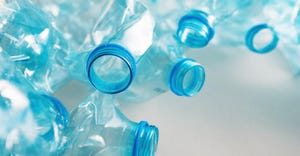technology: New Use for Old Tires
December 1, 1997
Bill Siuru
You can make old tires into new roads, play grounds and energy, but can you make them into new tires?
Until recently, that answer was "no." However, researchers at the Department of Energy's Pacific Northwest National Laboratory (PNNL), Richland, Wash., in cooperation with Rouse Rubber Industries, Vicksburg, Minn., are developing "RubberCycle," a new technology which increases the surface reactivity of ground tire rubber making used synthetic rubber reusable. Currently, one of the biggest challenges to mixing used rubber with a virgin rubber matrix is overcoming its particle surfaces' lack of reactive sites.
At the heart of PNNL's new technology is a bioreactor, where sulfur loving microorganisms - derived from strains of bacteria, Thiobacillus, Rhodoccus and Sulfolobus, originating in Yellowstone National Park's hot springs - modify carbon/sulfur cross-links in finely ground waste rubber.
Before entering the bioreactor, used tire rubber is ground into 74 micron size particles. The modification selectively metabolizes the sulfur, which was used as a vulcanizing agent during the original rubber's manufacture. The process changes the material from a nonreactive to a reactive filler.
After the bioprocessing is complete, the rubber is rinsed, filtered to remove the microorganisms and culture media and dried. The surface-modified rubber particles now are ready for mixing with virgin rubber to create new rubber compounds.
This highly selective bioprocess minimizes the degree of damage oc-curring to the polymer backbone of the rubber and allows the rubber particles to maintain many of their original physical properties. Indeed, improvements in the physical properties are seen in virgin rubber compounded with surface-modified ground tire rubber. These include:
* better rheological properties (materials flow easier during molding of products),
* increased hardness and
* better material integrity.
The recycled rubber also is less expensive than its virgin counterpart.
Preliminary economic analysis shows that the technology could recycle rubber with a potential profit margin of between 0.3 to 0.8 cents per pound of tire rubber. Also, the process is environmentally friendly: Bio-processing is performed at moderate temperatures, ambient pressure and uses no hazardous compounds or toxic chemicals. Additionally, many of the ingredients used in the process can be recycled.
The RubberCycle process has been demonstrated in the laboratory and now testing is being scaled up to 100-pound batches of rubber. So far, the research shows significant recycle content can be produced which then can be used to produce high-performance, moldable rubber goods, including car and truck tires.
Acquisitions Eastern Environmental Services Inc., Mt. Laurel, N.J., has signed a definitive agreement to acquire the 174-acre Pine Grove Landfill and the Pine Grove Hauling Co., located in east central Pennsylvania. The landfill and hauling company are projected to have gross revenues of approximately $18 million annually, prior to internal disposal costs.
Med/Waste Inc., Opa Locka, Fla., has purchased the assets of Environmental Waste Reductions Inc. (EWR), a medical waste hauler serving customers in Georgia, South Carolina, Tennessee and North Carolina. EWR's seller was a debtor-in-possession in a bankruptcy proceeding under Chapter 11 of the U.S. bankruptcy code.
You May Also Like


.png?width=300&auto=webp&quality=80&disable=upscale)